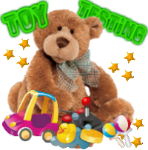Every year there are thousands of toys that hit the shelves of the toy stores. Buying a toy from a store is the best option, but there are plenty of other places you'll find toys being sold. As a responsible member of society we'd like to think that all toys are safe, regardless of where we buy them. But the truth of the matter is that there are unscrupulous manufacturers out there, and the authorities just can't keep track of everything that gets produced. This means that parents need to be extra vigilant when it comes to buying toys for their kids. Manufacturers do have to follow certain guidelines but there are plenty of times that certain toys slip though the regulatory net. So what can parents do to reduce the risks and keep their children as safe as possible? The following tips are certain to help anyone looking to buy toys for children.
Safety Tips for Those Buying Toys for Babies
- Don't buy toys with sharp edges or points
- Keep any toys designed for older children out of reach of babies and toddlers
- Young children and babies can be very destructive, so make sure the toys you give them are sturdy and have no moving parts that can easily be broken or taken off
- Pay attention to the labels and only buy age appropriate toys
- Look for toys that can be washed or for those that have non-toxic on the label, because baby's have a tendency to put everything in their mouths
- don't give your baby anything that's smaller than a couple of centimeters. Similarly, toys with stuffing made of beans or pellets should not be given to babies
- Don't give babies toys with ribbons, cords or loose string, to avoid the risk of it getting tangled around a baby's neck
- Don't give babies or toddlers toys that shoot objects or toy guns
- Only buy electrical toys that are approved
Older children are just as likely to come to harm or injure themselves when playing with toys, so let's give you some tips relating to toys for older children.
Choosing Safe Toys for Older Children
- Toys manufactured from fabric should have a label that states they are flame retardant or flame resistant
- Toys that are stuffed should be washable
- If a toy has been painted you need to be certain it is lead free paint
- Art materials should be marked nontoxic
- Crayons and paints should be marked that the have been tested and evaluated
Magnets are becoming much smaller and more powerful nowadays, so make sure that any toys containing these are kept away from children. This includes cards. If a child ingests more than one magnet they can stick together and become a very serious hazard and likely to cause very serious damage internally
If a toy contains a battery make sure the child is supervised while using it. If it is a rechargeable battery and requires a USB cable for charging be aware that such cables can overheat and lead to an increased risk of burn injuries
Making Your Toy Box Healthier for Your Children
We live in a world where we are encouraged to be more conscious of our environment and how the choices we make can impact on the world around us. As well as choosing safe toys, we thought we'd provide some tips on choosing toys that are Eco-friendly.
Natural materials – choose toys made from natural materials such as solid wood and organic textiles
Less is more – you can be much more Eco-friendly by buying fewer toys and not only will it better for the planet it will also be better for your bank balance
Re-purpose – rather than buying something new is there anything you already have that can be used as a toy?
Long-lasting – are the toys you're buying going to last very long? Can they be handed down to younger children in the future?
Labels – take the time to read what's on the labels, look at what the toy is made from and where it was made
Buy local – buying toys produced locally will reduce greenhouse gas emissions
Ditch the plastic – this isn't the easiest of tips to follow but try your best. If you have to buy plastic make sure it's recyclable
